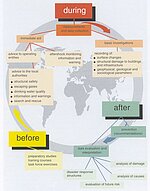German TaskForce for Earthquakes
overview
German TaskForce for Earthquakes was established to study the geophysical processes which emerge during and after catastrophic earthquake events. Furthermore, occurred damages are analyzed in order to clarify their reasons and thus to collect basic knowledge for sustainable damage limitation. These activities were and still are a German contribution to the "International Decade of Natural Disaster Reduction" (IDNDR, 1990-1999), respectively of the succeeding program ISDR (International Strategy for Disaster Reduction) by UNESCO. A wise processing of the project only can be achieved interdisciplinary. Therefore German TaskForce Committee for Earthquakes domiciled at GeoForschungsZentrum Potsdam was established. This capacious research establishment ought to coordinate the scientific and applied scientific operations in Germany and to organize the worldwide missions of interdisciplinary scientific-technical groups of experts into earthquake-disaster areas. According to different fields of interests different TaskForce groups are activated. The TaskForce pool of geophysical instruments is located at GFZ Potsdam. Missions abroad are only possible if a partner institute of the host country supports the TaskForce logistically. Both, data collection and posterior data analysis are to be carried out in close cooperation with the partner institute.
Since the year 1992 scientific staff members of Bauhaus-University Weimar join missions of German TaskForce for Earthquakes.
the TaskForce concept
the cycle: Before - During - After
A successful task force operates in cycles. Its operation entails intensive preparartion for the disaster mission, data collection and preliminary analysis during the catastrophe, and extensive analysis of the data after the event. Results and lessons from the analysis of one mission are developed for application to future eartquake disasters.


